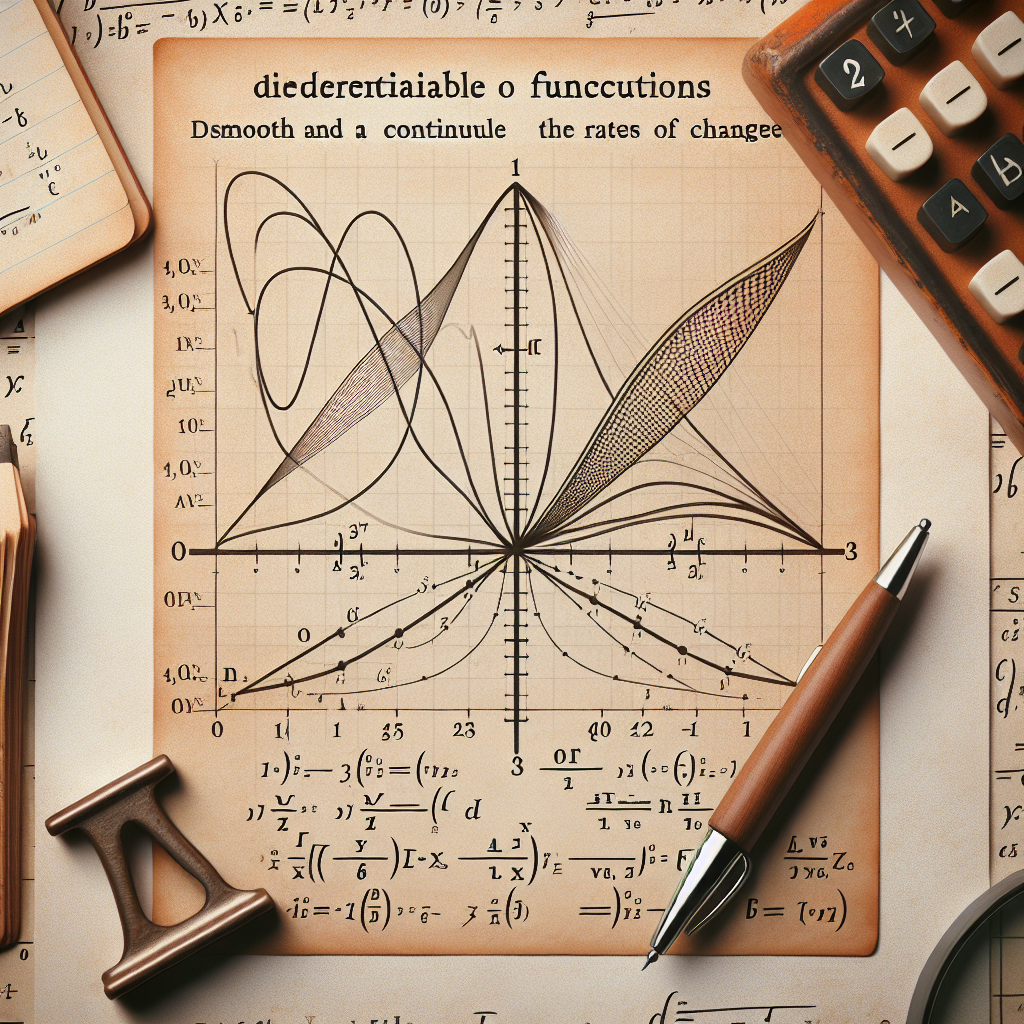Differentiable functions are a cornerstone of calculus. They play a crucial role in various mathematical disciplines.
But what exactly is a differentiable function? It's a function that has a derivative at every point in its domain. This means it's smooth, without any sharp corners or discontinuities.
The concept of differentiability is not just theoretical. It has practical applications in diverse fields. From physics to economics, differentiable functions help us model and understand the world.
In this article, we'll delve into the world of differentiable functions. We'll explore their properties, their graphs, and their real-world applications.
Whether you're a student, an educator, or a professional, this guide will provide valuable insights. So, let's embark on this mathematical journey together.
Understanding Differentiable Functions
Differentiable functions are a fundamental concept in calculus. They are functions that have a derivative at every point in their domain.
This means that you can draw a tangent line at any point on the graph of the function. The slope of this tangent line is the derivative of the function at that point.
Differentiable functions are smooth and continuous. They don't have any sharp corners or discontinuities.
Definition and Basic Concepts
A function is differentiable at a point if it has a derivative at that point. The derivative measures the rate of change of the function at that point.
In other words, the derivative tells us how the function is changing at a specific point. It's like the speedometer of a car, telling us how fast the car is going at a specific moment.
The concept of differentiability extends to the entire domain of a function. If a function has a derivative at every point in its domain, we say that the function is differentiable.
Differentiability and Continuity
Differentiability and continuity are closely related concepts. If a function is differentiable at a point, it is also continuous at that point.
However, the converse is not true. A function can be continuous at a point but not differentiable. For example, a function with a sharp corner is continuous but not differentiable at the corner.
The relationship between differentiability and continuity is a key concept in calculus. It helps us understand the behavior of functions and their graphs.
Criteria for Differentiability
For a function to be differentiable at a point, it must meet certain criteria. First, the function must be defined at that point.
Second, the function must be continuous at that point. This means that the function does not have any jumps, breaks, or holes at that point.
Finally, the function must have a derivative at that point. This means that the function's rate of change at that point is well-defined.
If a function meets these criteria at every point in its domain, it is a differentiable function.
The Graph of a Twice Differentiable Function
A twice differentiable function is a function that has a second derivative at every point in its domain. This means that not only does the function have a rate of change at every point, but the rate of change itself also has a rate of change.
The second derivative provides valuable information about the function. It tells us about the concavity of the function and helps us identify inflection points.
What Does Twice Differentiable Mean?
A function is twice differentiable if it has a second derivative. The second derivative is the derivative of the first derivative. It measures the rate of change of the rate of change.
In other words, the second derivative tells us how the slope of the tangent line is changing. If the slope is increasing, the function is concave up. If the slope is decreasing, the function is concave down.
A twice differentiable function is smooth and continuous, and its graph has a well-defined curvature at every point.
Visualizing Concavity and Inflection Points
The second derivative helps us visualize the concavity of a function. If the second derivative is positive, the function is concave up. If it's negative, the function is concave down.
An inflection point is a point where the function changes concavity. At an inflection point, the second derivative is zero.
By studying the second derivative, we can gain a deeper understanding of the function's behavior. We can identify its inflection points and understand how its rate of change is changing.
Common Examples of Differentiable Functions
Differentiable functions are everywhere in mathematics. They are the building blocks of many mathematical models and theories. Here are some common examples:
Polynomials
Exponential functions
Trigonometric functions
These functions are differentiable because they have a derivative at every point in their domain.
Polynomials and Exponential Functions
Polynomials are functions that involve powers of a variable. They are smooth and continuous, and they have a derivative at every point. This makes them differentiable.
Exponential functions, like the natural exponential function, are also differentiable. They have the unique property that their derivative is the same as the function itself.
These functions are fundamental in many areas of mathematics and science. They are used in modeling growth, decay, and many other phenomena.
Trigonometric Functions
Trigonometric functions, like sine and cosine, are also differentiable. They oscillate between positive and negative values, and their derivatives also oscillate.
The derivative of the sine function is the cosine function, and the derivative of the cosine function is the negative sine function.
These functions are essential in modeling periodic phenomena, like sound waves and light waves. They are also used in geometry, physics, and engineering.
Real-World Applications of Differentiable Functions
Differentiable functions are not just abstract mathematical concepts. They have many real-world applications. These functions are used in various fields, from economics to engineering, physics to machine learning.
In economics and engineering, differentiable functions are used to solve optimization problems. In physics, they are used to describe motion and dynamics. In machine learning, they are used to create predictive models.
These are just a few examples. The applications of differentiable functions are vast and varied.
Optimization Problems in Economics and Engineering
In economics, differentiable functions are used to model cost, revenue, and profit functions. By finding the derivative of these functions, economists can determine the rate of change and find the maximum or minimum points. This is crucial for making decisions about production and pricing.
In engineering, differentiable functions are used in optimization problems. For example, they can be used to minimize the material used in a construction project or maximize the efficiency of a machine. The derivative of the function gives the rate of change, which can be used to find the optimal solution.
Motion and Dynamics in Physics
In physics, differentiable functions are used to describe motion and dynamics. The position of an object can be represented as a function of time. The derivative of this function gives the velocity, and the second derivative gives the acceleration.
This is fundamental in classical mechanics. It allows physicists to predict the motion of objects under the influence of forces. Differentiable functions are also used in other areas of physics, like electromagnetism and quantum mechanics.
Predictive Models in Machine Learning
In machine learning, differentiable functions are used to create predictive models. These models are used to make predictions based on input data. The process of training these models often involves finding the minimum of a cost function, which is a differentiable function.
The derivative of the cost function is used to update the model parameters. This process, known as gradient descent, is a key part of many machine learning algorithms. Differentiable functions are also used in other aspects of machine learning, like neural networks and deep learning.
Advanced Concepts Involving Differentiable Functions
Differentiable functions are not just limited to basic calculus. They play a crucial role in more advanced mathematical concepts. These include higher-order derivatives, multivariable calculus, and topology.
These advanced concepts extend the idea of differentiability beyond simple functions. They allow us to explore more complex mathematical structures and phenomena.
Higher-Order Derivatives and Taylor Series
Higher-order derivatives refer to the derivatives of a function's derivative. They provide deeper insights into the behavior of a function. For instance, the second derivative can tell us about a function's concavity.
Taylor series is a powerful tool in calculus. It represents a function as an infinite sum of terms. These terms are calculated from the function's derivatives at a single point.
The concept of Taylor series is based on the idea of differentiability. It allows us to approximate complex functions using polynomials.
Partial Derivatives and Multivariable Calculus
In multivariable calculus, we deal with functions of more than one variable. Here, the concept of partial derivatives comes into play. A partial derivative measures the rate at which a function changes with respect to one of its variables, while keeping the others constant.
Partial derivatives are crucial in understanding surfaces and volumes. They are also used in optimization problems involving multiple variables.
Differentiable functions play a key role in multivariable calculus. They allow us to generalize the concepts of calculus to higher dimensions.
Differentiable Manifolds and Topology
Differentiable manifolds are a central concept in topology. They are spaces that locally resemble Euclidean space. On these spaces, we can define differentiable functions.
Differentiable manifolds are used in many areas of mathematics and physics. They are fundamental in the study of geometry, general relativity, and quantum field theory.
The concept of a differentiable manifold extends the idea of differentiability to more complex spaces. It allows us to apply calculus in a broader context.
The Importance of Differentiable Functions in Mathematics
Differentiable functions are a cornerstone of calculus. They provide a framework for understanding change and motion. This makes them invaluable in many fields of mathematics and beyond.
From optimization problems to modeling real-world phenomena, differentiable functions are everywhere. They help us make predictions, solve complex problems, and understand the world around us.
In advanced mathematics, differentiable functions play a key role. They allow us to generalize the concepts of calculus to higher dimensions and more complex spaces.
In summary, differentiable functions are a fundamental tool in mathematics. They provide a powerful way to describe and analyze the world.
Summary of Key Takeaways
Differentiable functions are a central concept in calculus. They describe how a quantity changes with respect to another. This makes them a powerful tool for understanding and predicting change.
The concept of differentiability extends beyond simple functions. It plays a crucial role in advanced mathematical concepts like higher-order derivatives, multivariable calculus, and topology.
Differentiable functions are a fundamental tool in mathematics. They provide a powerful way to describe and analyze the world.
Further Reading and Resources
For those interested in learning more about differentiable functions, there are many resources available. These include textbooks, online courses, and tutorials.













.jpg)




0 Comments